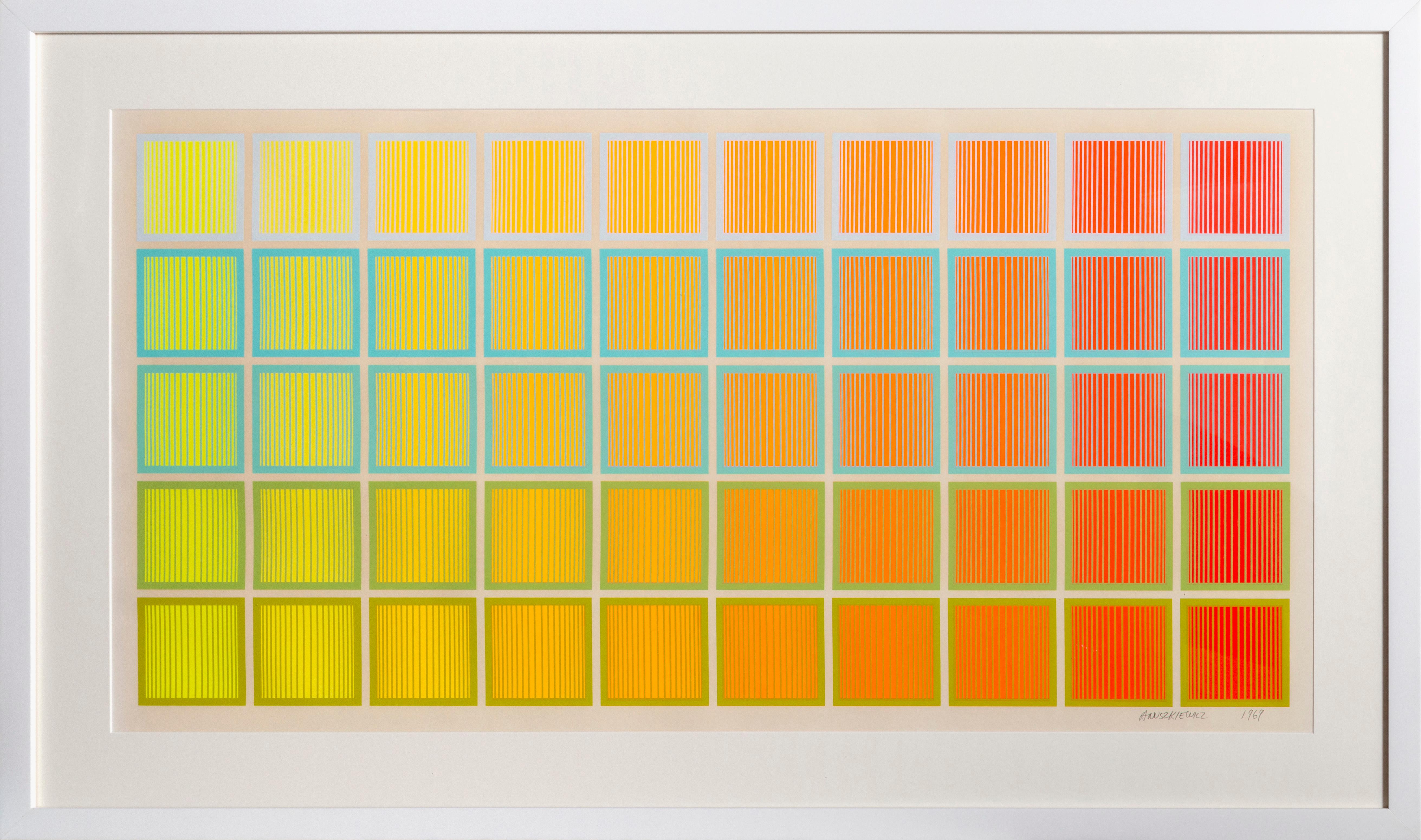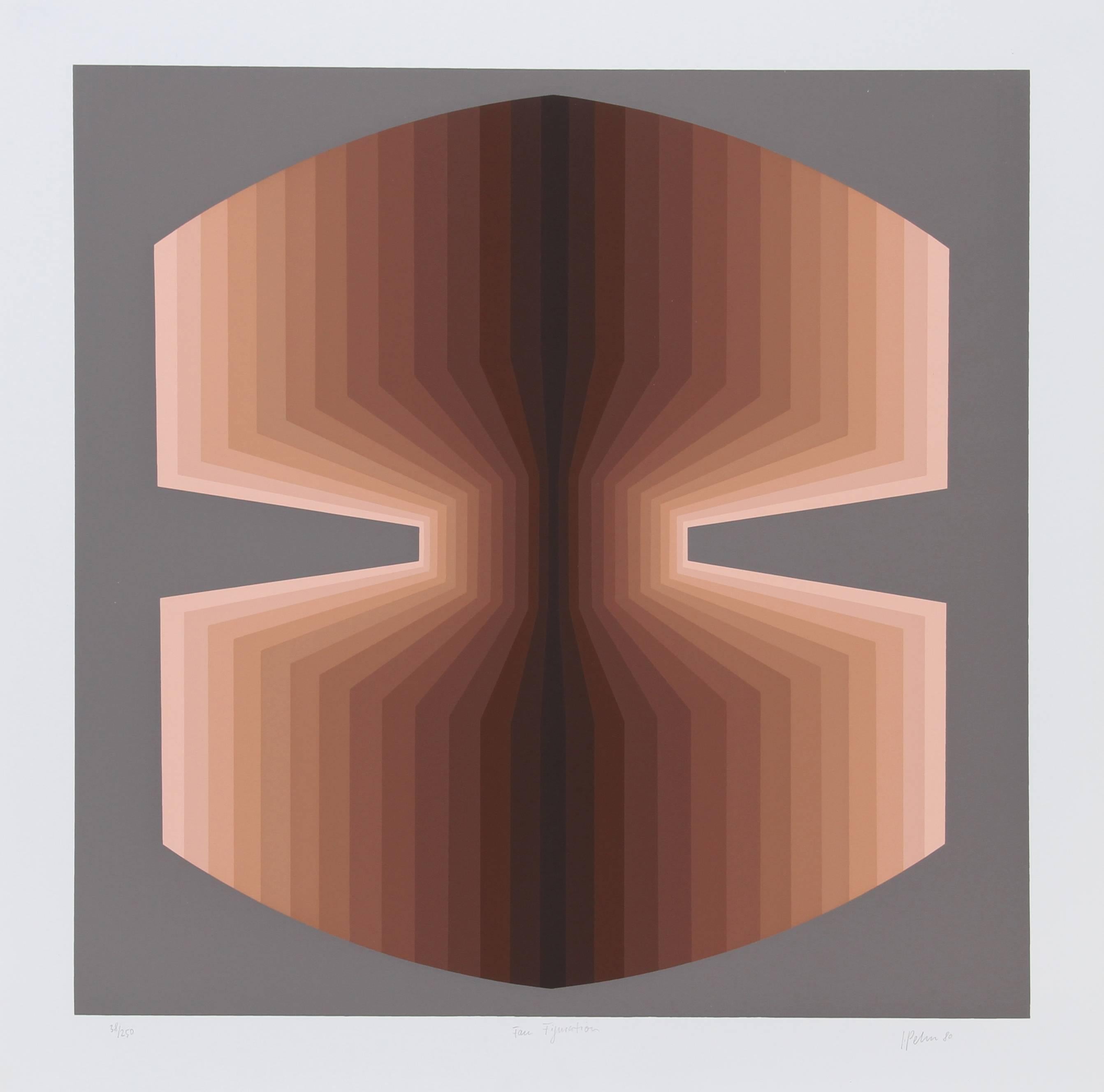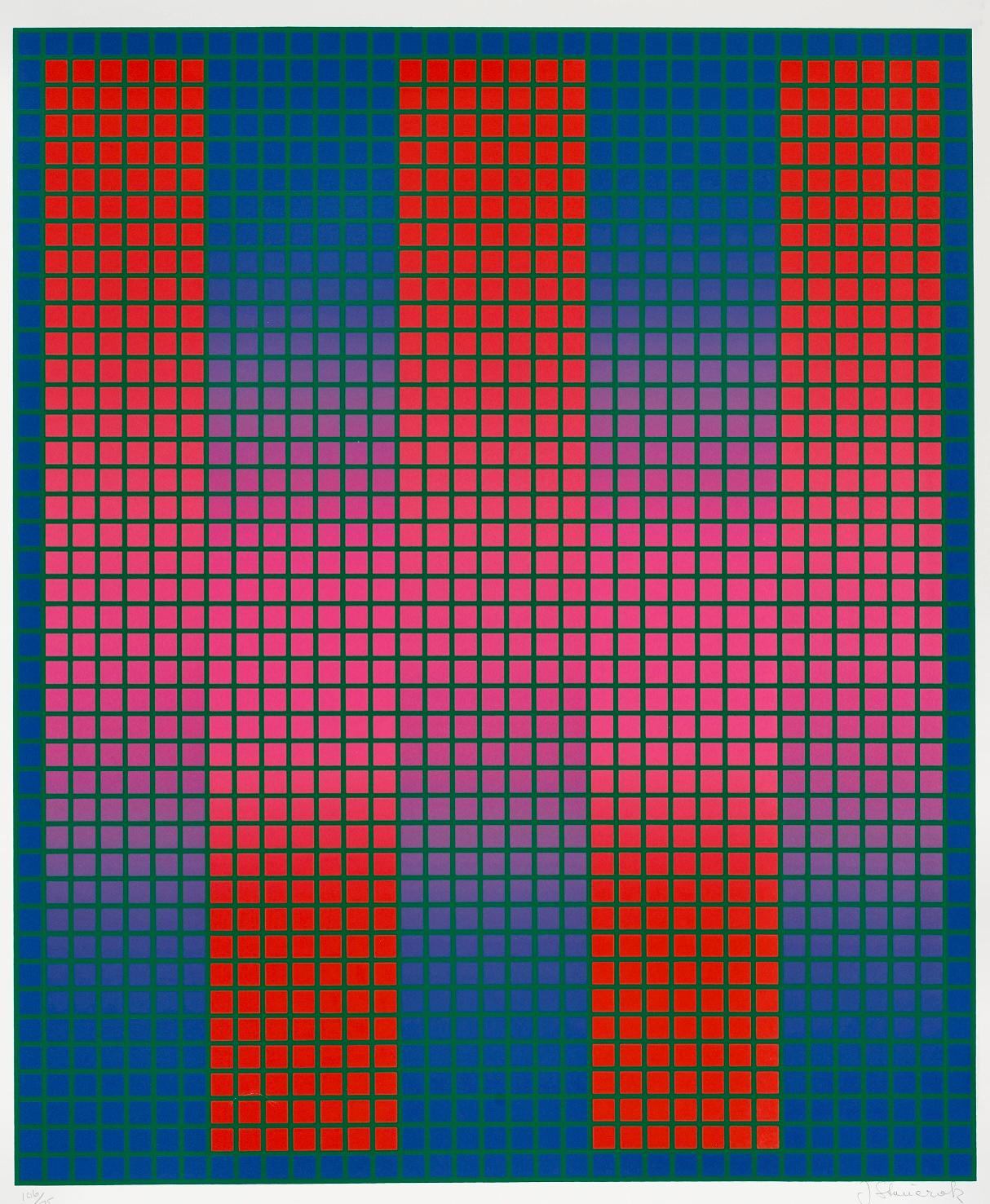Victor VasarelyBanya, 1964 Vintage Abstract Op Art Screen Print Serigraph 1964
1964
About the Item
- Creator:Victor Vasarely (1906 - 1997, French, Hungarian)
- Creation Year:1964
- Dimensions:Height: 23.5 in (59.69 cm)Width: 23.5 in (59.69 cm)
- Medium:
- Movement & Style:
- Period:
- Condition:Good condition, frame needs some fastening.
- Gallery Location:Surfside, FL
- Reference Number:1stDibs: LU38211300392
Victor Vasarely
Widely considered the grandfather of Op art, the French-Hungarian painter Victor Vasarely (1906–97) created eye-popping geometric abstractions that play with the viewer’s perception of depth, perspective and motion. A classic example is the 1937 Zebra, which consists of undulating black and white stripes that suggest the form of the titular animal through optical trickery. The work is often credited as the earliest Op art painting.
Such illusions were more than pleasing tricks for Vasarely, who insisted that “pure form and pure color can signify the world.” He wanted to “democratize” art by producing works in large editions at reasonable prices that were understandable across national and cultural boundaries. In the 1960s, he developed an alphabet plastique, or fine art alphabet, consisting of elementary visual building blocks that could be used in endless combinations to create original compositions. By employing this universal visual vocabulary and stripping away topical references, he sought to create what he called a “Planetary Folklore.”
Embodying Vasarely’s singular belief that art should serve a social function, accessible to all, these innovations may perhaps be his greatest contribution to 20th-century art.
Find a collection of Victor Vasarely prints, paintings, sculptures and other art on 1stDibs.
- ShippingRetrieving quote...Ships From: Surfside, FL
- Return PolicyA return for this item may be initiated within 3 days of delivery.
- Agam Lenticular Kinetic Agamograph Hand Signed numbered Israeli Kinetic Op ArtBy Yaacov AgamLocated in Surfside, FLYaacov Agam, Israeli (b. 1928) Hand signed, and numbered. Limited edition lenticular lens kinetic Agamograph Titled 'Sea Fathom'. Hand-signed and numbered edition 24/99, size of w...Category
20th Century Op Art Abstract Prints
MaterialsScreen, Lenticular
- Agam Silkscreen Mod Judaica Lithograph Hand Signed Israeli Kinetic Op Art PrintBy Yaacov AgamLocated in Surfside, FLYaacov Agam Israeli (b. 1928) Hand signed, not individually numbered but from edition of 180. I can include a copy of the title sheet with the edition size and his signature if you request. sheet: 13.5 X 13.5 inches Some of these works have beautiful Hebrew calligraphy and mod imagery, animals, children and such that are not usually found in his work. This is a masterpiece of bold, graphic, mod design. Along with Reuven Rubin and Menashe Kadishman he is among Israel's best known artists internationally. Biographical info: The son of a rabbi, Yaacov Agam can trace his ancestry back six generations to the founder of the Chabad movement in Judaism. in 1946, he entered the Bezalel Academy of Arts and Design in Jerusalem. Studying with Mordecai Ardon, a former student at the Weimar Bauhaus. Yaakov Agam has been associated h with “abstract” artists, “hard edge” artists, and artists such as Josef Albers and Max Bill. Others find in Agam’s work an indebtedness to the masters of the Bauhaus. Agam’s approach to art, being conceptual in nature, has been likened to Marcel Duchamp’s, who expressed the need to put art “at the service of the spirit.” And, because of Agam’s employment of color and motion in his art, he has been compared to Alexander Calder, the artist who put sculpture into motion. (Motion is not an end, but a means for Agam. Calder’s mobiles are structures that are fixed, revolving at the whim of the wind. In a work by Agam, the viewer must intervene.) Agam has also been classified as an “op art” artist because he excels in playing with our visual sensitivities. Agam went to Zurich to study with Johannes Itten at the Kunstgewerbeschule. There, he met Frank Lloyd Wright and Siegfried Giedion, whose ideas on the element of time in art and architecture impressed him. In 1955, Galerie Denise René hosted a major group exhibition in connection with Vasarely's painting experiments with movement. in addition to art by Vasarely, it included works by Yaacov Agam, Pol Bury, Soto and Jean Tinguely, among others. Most Americans were first introduced to Vasarely by the groundbreaking exhibition, "The Responsive Eye," at New York's Museum of Modern Art in 1965. Josef Albers, Richard Anuszkiewicz. The show confirmed Vasarely's international reputation as the father of Op art. Agam has sought to express his ideas in a non-static form of art. In his abstract Kinetic works, which range from paintings and graphics to sculptural installations and building facades. Agam continually seeks to explore new possibilities in form and color and to involve the viewer in all aspects of the artistic process. Thus, for the past 40 years, Yaacov Agam’s pioneering ideas have impacted developments in art, (painting, monoprint, lithograph and agamograph) architecture, theatre, and public sculpture. Reflecting both his Israeli Jewish...Category
1980s Op Art Abstract Prints
MaterialsLithograph, Screen
- Agam Silkscreen Jerusalem Lithograph Hand Signed Israeli Kinetic Op Art PrintBy Yaacov AgamLocated in Surfside, FLYaacov Agam, Israeli (b. 1928) Hand signed, not individually numbered but from edition of 180. I can include a copy of the title sheet with the edition size and his signature if you ...Category
1980s Op Art Abstract Prints
MaterialsLithograph, Screen
- Agam Silkscreen Mod Judaica Lithograph Hand Signed Israeli Kinetic Op Art PrintBy Yaacov AgamLocated in Surfside, FLYaacov Agam Israeli (b. 1928) Hand signed, not individually numbered but from edition of 180. I can include a copy of the title sheet with the edition size and his signature if you request. sheet: 13.5 X 13.5 inches Some of these works have beautiful Hebrew calligraphy and mod imagery, animals and such that are not usually found in his work. This is a masterpiece of bold, graphic, mod design. Along with Reuven Rubin and Menashe Kadishman he is among Israel's best known artists internationally. Biographical info: The son of a rabbi, Yaacov Agam can trace his ancestry back six generations to the founder of the Chabad movement in Judaism. in 1946, he entered the Bezalel Academy of Arts and Design in Jerusalem. Studying with Mordecai Ardon, a former student at the Weimar Bauhaus. Yaakov Agam has been associated h with “abstract” artists, “hard edge” artists, and artists such as Josef Albers and Max Bill. Others find in Agam’s work an indebtedness to the masters of the Bauhaus. Agam’s approach to art, being conceptual in nature, has been likened to Marcel Duchamp’s, who expressed the need to put art “at the service of the spirit.” And, because of Agam’s employment of color and motion in his art, he has been compared to Alexander Calder, the artist who put sculpture into motion. (Motion is not an end, but a means for Agam. Calder’s mobiles are structures that are fixed, revolving at the whim of the wind. In a work by Agam, the viewer must intervene.) Agam has also been classified as an “op art” artist because he excels in playing with our visual sensitivities. Agam went to Zurich to study with Johannes Itten at the Kunstgewerbeschule. There, he met Frank Lloyd Wright and Siegfried Giedion, whose ideas on the element of time in art and architecture impressed him. In 1955, Galerie Denise René hosted a major group exhibition in connection with Vasarely's painting experiments with movement. in addition to art by Vasarely, it included works by Yaacov Agam, Pol Bury, Soto and Jean Tinguely, among others. Most Americans were first introduced to Vasarely by the groundbreaking exhibition, "The Responsive Eye," at New York's Museum of Modern Art in 1965. Josef Albers, Richard Anuszkiewicz. The show confirmed Vasarely's international reputation as the father of Op art. Agam has sought to express his ideas in a non-static form of art. In his abstract Kinetic works, which range from paintings and graphics to sculptural installations and building facades. Agam continually seeks to explore new possibilities in form and color and to involve the viewer in all aspects of the artistic process. Thus, for the past 40 years, Yaacov Agam’s pioneering ideas have impacted developments in art, (painting, monoprint, lithograph and agamograph) architecture, theatre, and public sculpture. Reflecting both his Israeli Jewish...Category
1980s Op Art Abstract Prints
MaterialsLithograph, Screen
- 1970's Op Art Cintique Geometric Abstract Color Gradations Silkscreen DombergerLocated in Surfside, FLSilkscreen serigraph Op art print. Luitpold Domberger (1912-2005 ) was a pioneer of artistic screen printing in Germany. Luitpold (Poldi) Domberger...Category
1970s Op Art Abstract Prints
MaterialsScreen
- Agam Silkscreen Mod Judaica Lithograph Hand Signed Israeli Kinetic Op Art PrintBy Yaacov AgamLocated in Surfside, FLYaacov Agam Israeli (b. 1928) Hand signed, not individually numbered but from edition of 180. I can include a copy of the title sheet with the edition size and his signature if you r...Category
1980s Op Art Abstract Prints
MaterialsLithograph, Screen
- 1920 League of Women Voters, Large OP Art Screenprint by Anuszkiewicz 1969By Richard AnuszkiewiczLocated in Long Island City, NYArtist: Richard Anuszkiewicz, American (1930 - ) Title: 1920 League of Women Voters Year: 1969 Medium: Screenprint, signed, numbered, and dated ...Category
1970s Op Art Abstract Prints
MaterialsScreen
- "Fan Figuration, " Serigraph, 1980By Jurgen PetersLocated in Long Island City, NYThis serigraph was created by German artist Jurgen Peters. Peters was a very well known optical artist in the 1970s, he was a contemporary of Victor Vasarely, Yaacov Agam and Briget Riley...Category
1980s Op Art Abstract Prints
MaterialsScreen
- "Starry, Starry Night", Op Art Serigraph by Roy AhlgrenBy Roy AhlgrenLocated in Long Island City, NYThis swirling chrome and silver print is named in reference to the famous painting “Starry Night” by Vincent van Gogh. The spiral that pulls at the center of the composition is remin...Category
1980s Op Art Abstract Prints
MaterialsScreen
- Mobius, Op Art Screenprint by Roy AhlgrenBy Roy AhlgrenLocated in Long Island City, NYArtist: Roy Ahlgren, American (1927 - 2011) Title: Mobius Year: 1978 Medium: Serigraph, signed and numbered in pencil Edition: 80 Image Size: 18 x 26 inches Size: 22 x 30 in. (...Category
1970s Op Art Abstract Prints
MaterialsScreen
- Trespass, Julian StanczakBy Julian StanczakLocated in Fairfield, CTArtist: Julian Stanczak (1928-2017) Title: Trespass Year: 1979 Edition: 106/175, plus proofs Medium: Silkscreen on Somerset paper Size: 26.75 x 22.5 inches Condition: Good Inscriptio...Category
1970s Op Art Landscape Prints
MaterialsScreen
- Sequential Chroma, Julian StanczakBy Julian StanczakLocated in Fairfield, CTArtist: Julian Stanczak (1928-2017) Title: Sequential Chroma Year: 1978 Edition: 2/175, plus proofs Medium: Silkscreen on Somerset paper Size: 30.25 x 25.75 inches Condition: Good In...Category
1970s Op Art Landscape Prints
MaterialsScreen




